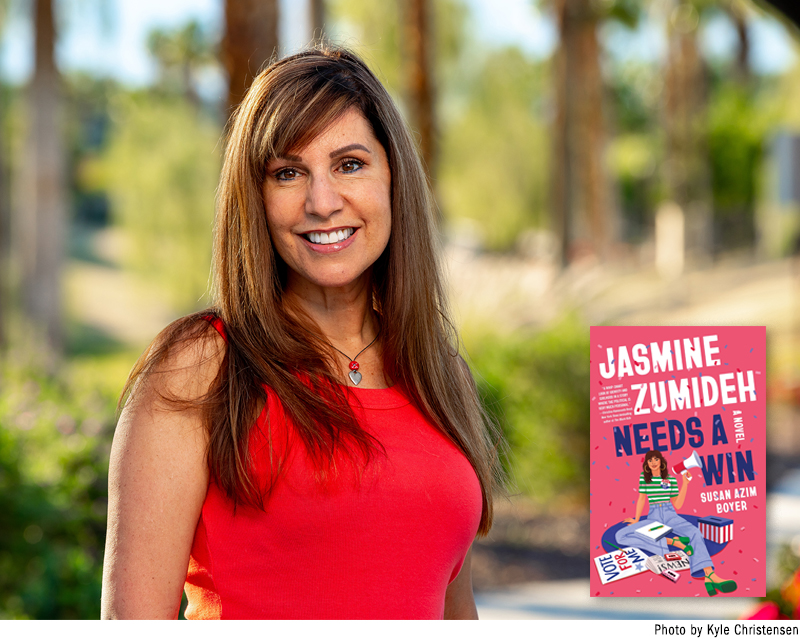Debut Authors Counter Harmful Narratives with Kid Lit | A Guest Essay by Susan Azim Boyer
In this guest essay, debut author Susan Azim Boyer speaks with five fellow debut authors about why they write kid lit and how it can act as a powerful force against harmful narratives and stereotypes.

In this culture of 24/7 access to unfiltered media, harmful narratives abound about Muslims after 9/11, Chinese Americans in the wake of COVID, the “danger” of trans youth—the list goes on. And it’s not just the media. Such narratives propagate longstanding prejudice and preconceptions about, for instance, Black, brown, and Indigenous people.
My debut novel, Jasmine Zumideh Needs a Win, was born out of a desire to counter the harmful narrative about Iranians that exploded following the 1979 Iran Hostage Crisis (they’re all terrorists) when Iran became an international pariah overnight. I wanted to give teen readers a better understanding of the crisis and a context for it; I wanted them to see Iranian Americans as human, funny, and relatable.
Recently, I spoke with five fellow debut authors about why they write kid lit and how it can act as a powerful force against these narratives.
 To start, I asked about the specific harm done. South Asian author Maya Prasad (Drizzle, Dreams, and Lovestruck Things) says harmful narratives can make young people feel “othered” and lead to real-world violence. “It also exacerbates teens' mental health crisis when they see relentlessly negative depictions of themselves or their cultures, which can be internalized as shame or self-loathing.” She purposely created a loving, joyful family in her YA romance to counteract the tendency for the immigrant experience to be viewed as traumatic.
To start, I asked about the specific harm done. South Asian author Maya Prasad (Drizzle, Dreams, and Lovestruck Things) says harmful narratives can make young people feel “othered” and lead to real-world violence. “It also exacerbates teens' mental health crisis when they see relentlessly negative depictions of themselves or their cultures, which can be internalized as shame or self-loathing.” She purposely created a loving, joyful family in her YA romance to counteract the tendency for the immigrant experience to be viewed as traumatic.
Charlene Thomas (Seton Girls), who is Black, says she was inspired to write her novel after consuming tons of media as a young, Black girl where characters of color were often sidekicks, implying that they were not worthy of center stage. “I think it’s really important to showcase Black and brown girls as the stars, the heroes, being popular and pretty.” In Seton Girls, it’s the strong bond of friendship between the girls that enables them to expose the corruption protecting the school’s privileged white boys.
Latinex author Vanessa L. Torres (The Turning Pointe) echoes this sentiment: “Growing up as one of the few Latinx families in Minneapolis, I saw very few positive depictions of Latinx people in books, TV, or movies. We were not allowed to speak Spanish outside the home as if it were something to be ashamed of.” Her main character, aspiring prima ballerina Rosa Dominguez, also battles a negative narrative around body type: “Dancers with curves are not wanted. Everyone has to conform to a Western European standard of beauty.” It would have made all the difference if she could have seen herself positively depicted in the media.
Author and educator Jen Ferguson, who is Métis and white, wrote The Summer of Bitter and Sweet to counteract what she views as the dominant narrative around Native people: that they only exist in the distant past. “Native people exist in the present, and Native teens should be allowed to see themselves as messy and struggling with mental illness and not making the right decisions all the time.”
Like Torres, Taiwanese American Anna Gracia (Boys I Know) grew up in a predominantly white Midwest neighborhood, which came with stereotypes about culture and sex. “I wrote Boys I Know to counteract the negative narrative around sex that makes young women, especially, feel ashamed for engaging in normal, sexual exploration, for needing contraception, or even an abortion.” In fact, Gracia gave out branded condoms to promote the book!
Everyone agrees that seeing themselves reflected in literature is one of the most powerful tools to help counteract harmful narratives.
“Librarians play a critical role,” says Ferguson. “They can weed out books that perpetuate harmful stereotypes and replace them with books that center marginalized voices.” She encourages librarians to select books from “insider” authors whose lived experience aligns with their characters.
Thomas—who comes from a family of educators and whose father was a high school principal—suggests creating booklists that pair modern alternatives with classic books not only to counter possibly outdated or offensive depictions but also to help students recognize the relevancy of certain themes in today’s world. She knows it may not always be easy, but believes educators are in a special position “to have these difficult conversations, especially when a harmful narrative is dominating the news cycle.”
Ferguson concurs and adds, “By the way, it’s okay for students to feel uncomfortable discussing difficult topics like race and gender, as long as they don’t feel unsafe.” Torres advises librarians to consider starting book clubs for marginalized teens including BIPOC, queer, and disabled readers. Prasad agrees, adding, “You might even be able to get a local author to speak.”
We invite you to start with the six of us.
RELATED
The job outlook in 2030: Librarians will be in demand
The job outlook in 2030: Librarians will be in demand
ALREADY A SUBSCRIBER? LOG IN
We are currently offering this content for free. Sign up now to activate your personal profile, where you can save articles for future viewing






Add Comment :-
Be the first reader to comment.
Comment Policy:
Comment should not be empty !!!